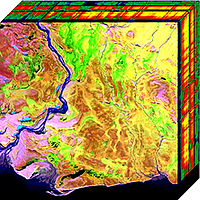
Photo from wikipedia
Remotely sensed hyperspectral data can support more effective water quality monitoring. Nevertheless, the variability and complexity of urban river water make it hard to retrieve comprehensive water quality characteristics directly,… Click to show full abstract
Remotely sensed hyperspectral data can support more effective water quality monitoring. Nevertheless, the variability and complexity of urban river water make it hard to retrieve comprehensive water quality characteristics directly, so that most current water quality assessments rely on semi-empirical, semi-analytical or bio-optical approaches. In this study, we carried out simultaneous in-situ hyperspectral data and water quality measurements. We used the 382 hyperspectral data from urban rivers of Zhongshan City in the Pearl River Delta to test how well the Random Forest (RF) and One-dimensional Convolutional Neural Networks (1D-CNN) algorithms retrieved the newly established water quality index (WQI). The RF algorithm also identified essential wavelengths for retrieving the WQI. Our results demonstrate that the RF and 1D-CNN algorithms performed well in WQI estimations. The 1D-CNN model performed significantly better than the RF model, especially on high WQI samples. Both models were insensitive to smoothing of the hyperspectral data, showing that the noise of the original hyperspectral reflectance data has a limited impact on the algorithms. Additionally, when we used the essential wavelength data (mainly located between 580 nm to 590 nm and near 722 nm, 751nm, 821 nm, 830 nm) as input data, we achieved better retrieval results. The 1D-CNN model performed the best with an R2 of 0.87, RMSE of 0.574, and RPIQ of 3.082 when we used the top 10th percentile of the essential wavelength data. This study demonstrates the potential of the 1D-CNN algorithm for hyperspectral data analysis to retrieve comprehensive water quality.
Journal Title: IEEE Transactions on Geoscience and Remote Sensing
Year Published: 2022
Link to full text (if available)
Share on Social Media: Sign Up to like & get
recommendations!